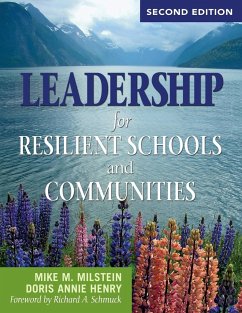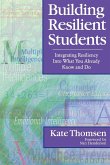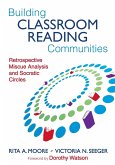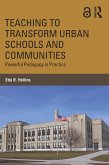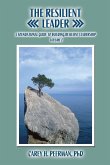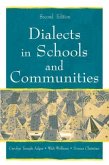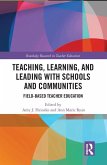- Broschiertes Buch
- Merkliste
- Auf die Merkliste
- Bewerten Bewerten
- Teilen
- Produkt teilen
- Produkterinnerung
- Produkterinnerung
Combining proven strategies with new information for developing resiliency in schools, this edition emphasizes the critical role of school leaders and features updated exercises for implementing change.
Andere Kunden interessierten sich auch für
![Building Resilient Students Building Resilient Students]() Kate ThomsenBuilding Resilient Students42,99 €
Kate ThomsenBuilding Resilient Students42,99 €![Building Classroom Reading Communities Building Classroom Reading Communities]() Rita A. MooreBuilding Classroom Reading Communities35,99 €
Rita A. MooreBuilding Classroom Reading Communities35,99 €![Teaching to Transform Urban Schools and Communities Teaching to Transform Urban Schools and Communities]() Etta R. HollinsTeaching to Transform Urban Schools and Communities61,99 €
Etta R. HollinsTeaching to Transform Urban Schools and Communities61,99 €![The Resilient Leader The Resilient Leader]() Carey H PeermanThe Resilient Leader37,99 €
Carey H PeermanThe Resilient Leader37,99 €![Decentralizing Centralized Control: Reorienting a Fundamental Tenet for Resilient Air Operations Decentralizing Centralized Control: Reorienting a Fundamental Tenet for Resilient Air Operations]() Mark E. BlommeDecentralizing Centralized Control: Reorienting a Fundamental Tenet for Resilient Air Operations63,99 €
Mark E. BlommeDecentralizing Centralized Control: Reorienting a Fundamental Tenet for Resilient Air Operations63,99 €![Dialects in Schools and Communities Dialects in Schools and Communities]() Carolyn Temple AdgerDialects in Schools and Communities67,99 €
Carolyn Temple AdgerDialects in Schools and Communities67,99 €![Teaching, Learning, and Leading with Schools and Communities Teaching, Learning, and Leading with Schools and Communities]() Teaching, Learning, and Leading with Schools and Communities63,99 €
Teaching, Learning, and Leading with Schools and Communities63,99 €-
-
-
Combining proven strategies with new information for developing resiliency in schools, this edition emphasizes the critical role of school leaders and features updated exercises for implementing change.
Hinweis: Dieser Artikel kann nur an eine deutsche Lieferadresse ausgeliefert werden.
Hinweis: Dieser Artikel kann nur an eine deutsche Lieferadresse ausgeliefert werden.
Produktdetails
- Produktdetails
- Verlag: Corwin
- 2. Auflage
- Seitenzahl: 202
- Erscheinungstermin: 11. Dezember 2007
- Englisch
- Abmessung: 280mm x 216mm x 11mm
- Gewicht: 523g
- ISBN-13: 9781412955942
- ISBN-10: 1412955947
- Artikelnr.: 23006827
- Herstellerkennzeichnung
- Libri GmbH
- Europaallee 1
- 36244 Bad Hersfeld
- gpsr@libri.de
- Verlag: Corwin
- 2. Auflage
- Seitenzahl: 202
- Erscheinungstermin: 11. Dezember 2007
- Englisch
- Abmessung: 280mm x 216mm x 11mm
- Gewicht: 523g
- ISBN-13: 9781412955942
- ISBN-10: 1412955947
- Artikelnr.: 23006827
- Herstellerkennzeichnung
- Libri GmbH
- Europaallee 1
- 36244 Bad Hersfeld
- gpsr@libri.de
Mike M. Milstein is a partner in The Resiliency Group, Ltd., and Professor Emeritus of Educational Leadership at the University of New Mexico. His professional career also includes being Professor of Educational Leadership at the University of Buffalo and a classroom teacher. His teaching, research, and writing interests are in the areas of resiliency and organizational change and development. He has been actively engaged in school and community resiliency development efforts in such places as Nelson, New Zealand, Ashland, Oregon; Battle Creek, Michigan; and Shelby County, Tennessee. The resiliency initiatives he has facilitated include classroom instruction and curriculum improvement efforts, school wide activities that enhance the resiliency of educators, and school-community partnerships that support resiliency development for both children and adults. He has written 11 books, including coauthoring Resiliency in Schools (2002; 1996).
Dedication
List of Tables and Figures
List of Handouts
Foreword by Richard A. Schmuck
Foreword to the First Edition by Paul D. Houston
Preface
Organization of the Book
About the Authors
Part I. Basic Concepts
1. Resiliency: Promoting Everyone's Potential to Succeed
Why the Urgency?
An Introduction to Resiliency
The Problem With Problem Solvers
2. Building Resilient Communities
Why Community Development and Resiliency
Traditional Ways of Thinking About Community
Three Realities of Community: Rural, Urban, and Suburban
Visualizing the Resilient Community
Leadership Activities for Building a Resilient Community: Where Do We
Start?
Part II. Resiliency for Everyone
3. Student Resiliency: Building a Base for Positive Living
What Are the Problems That Youth Face?
Changing Our Mind Maps: From Deficits to Potentials
Student Resiliency: The Community and School's Responsibilities
Leadership Strategies That Promote Student Resiliency
Bringing It All Together as an Overall Resiliency-Building Approach
4. Educator Resiliency: Nurturing the Nurturers
Resiliency Pathways and Educators' Performance Over Their Career Span
The Ability of Educators to Perform Well Over Time: Coping With Plateauing
The Impact of the School Environment on Educator Resiliency
Strategies to Overcome School-Based Barriers to Educator Resiliency
5. School Resiliency: Creating Supportive Environments for Students,
Educators, and Communities
Does Your School Support Resiliency?
Improving School Resiliency Means Changing Schools
Backwards Planning
School Resiliency-Building Strategies
6. Community Resiliency: Developing Partnerships
Building Relationships Between Schools and Their Communities
Communities With Characteristics of Resiliency
Community Support Is Needed for School Resiliency
School Support Is Needed for Community Resiliency
From Reactive to Proactive Community Relationships
Strategies for Improving Community Resiliency
Part III. Making It Happen for Schools & Communities
7. Leading Resiliency Development Initiatives: Strategies for Managing and
Assessing Change
Bringing It All Together and Leading Resiliency Development Initiatives
The Four Stages of Change
Group Development
Leadership Needs
Facilitation Skills
Assessment, Monitoring, and Evaluation
8. School and Community Resiliency Initiatives
A Reality Perspective
Communities on the Forefront of Improvement
In Closing
Resource A: Handouts
References
Index
List of Tables and Figures
List of Handouts
Foreword by Richard A. Schmuck
Foreword to the First Edition by Paul D. Houston
Preface
Organization of the Book
About the Authors
Part I. Basic Concepts
1. Resiliency: Promoting Everyone's Potential to Succeed
Why the Urgency?
An Introduction to Resiliency
The Problem With Problem Solvers
2. Building Resilient Communities
Why Community Development and Resiliency
Traditional Ways of Thinking About Community
Three Realities of Community: Rural, Urban, and Suburban
Visualizing the Resilient Community
Leadership Activities for Building a Resilient Community: Where Do We
Start?
Part II. Resiliency for Everyone
3. Student Resiliency: Building a Base for Positive Living
What Are the Problems That Youth Face?
Changing Our Mind Maps: From Deficits to Potentials
Student Resiliency: The Community and School's Responsibilities
Leadership Strategies That Promote Student Resiliency
Bringing It All Together as an Overall Resiliency-Building Approach
4. Educator Resiliency: Nurturing the Nurturers
Resiliency Pathways and Educators' Performance Over Their Career Span
The Ability of Educators to Perform Well Over Time: Coping With Plateauing
The Impact of the School Environment on Educator Resiliency
Strategies to Overcome School-Based Barriers to Educator Resiliency
5. School Resiliency: Creating Supportive Environments for Students,
Educators, and Communities
Does Your School Support Resiliency?
Improving School Resiliency Means Changing Schools
Backwards Planning
School Resiliency-Building Strategies
6. Community Resiliency: Developing Partnerships
Building Relationships Between Schools and Their Communities
Communities With Characteristics of Resiliency
Community Support Is Needed for School Resiliency
School Support Is Needed for Community Resiliency
From Reactive to Proactive Community Relationships
Strategies for Improving Community Resiliency
Part III. Making It Happen for Schools & Communities
7. Leading Resiliency Development Initiatives: Strategies for Managing and
Assessing Change
Bringing It All Together and Leading Resiliency Development Initiatives
The Four Stages of Change
Group Development
Leadership Needs
Facilitation Skills
Assessment, Monitoring, and Evaluation
8. School and Community Resiliency Initiatives
A Reality Perspective
Communities on the Forefront of Improvement
In Closing
Resource A: Handouts
References
Index
Dedication
List of Tables and Figures
List of Handouts
Foreword by Richard A. Schmuck
Foreword to the First Edition by Paul D. Houston
Preface
Organization of the Book
About the Authors
Part I. Basic Concepts
1. Resiliency: Promoting Everyone's Potential to Succeed
Why the Urgency?
An Introduction to Resiliency
The Problem With Problem Solvers
2. Building Resilient Communities
Why Community Development and Resiliency
Traditional Ways of Thinking About Community
Three Realities of Community: Rural, Urban, and Suburban
Visualizing the Resilient Community
Leadership Activities for Building a Resilient Community: Where Do We
Start?
Part II. Resiliency for Everyone
3. Student Resiliency: Building a Base for Positive Living
What Are the Problems That Youth Face?
Changing Our Mind Maps: From Deficits to Potentials
Student Resiliency: The Community and School's Responsibilities
Leadership Strategies That Promote Student Resiliency
Bringing It All Together as an Overall Resiliency-Building Approach
4. Educator Resiliency: Nurturing the Nurturers
Resiliency Pathways and Educators' Performance Over Their Career Span
The Ability of Educators to Perform Well Over Time: Coping With Plateauing
The Impact of the School Environment on Educator Resiliency
Strategies to Overcome School-Based Barriers to Educator Resiliency
5. School Resiliency: Creating Supportive Environments for Students,
Educators, and Communities
Does Your School Support Resiliency?
Improving School Resiliency Means Changing Schools
Backwards Planning
School Resiliency-Building Strategies
6. Community Resiliency: Developing Partnerships
Building Relationships Between Schools and Their Communities
Communities With Characteristics of Resiliency
Community Support Is Needed for School Resiliency
School Support Is Needed for Community Resiliency
From Reactive to Proactive Community Relationships
Strategies for Improving Community Resiliency
Part III. Making It Happen for Schools & Communities
7. Leading Resiliency Development Initiatives: Strategies for Managing and
Assessing Change
Bringing It All Together and Leading Resiliency Development Initiatives
The Four Stages of Change
Group Development
Leadership Needs
Facilitation Skills
Assessment, Monitoring, and Evaluation
8. School and Community Resiliency Initiatives
A Reality Perspective
Communities on the Forefront of Improvement
In Closing
Resource A: Handouts
References
Index
List of Tables and Figures
List of Handouts
Foreword by Richard A. Schmuck
Foreword to the First Edition by Paul D. Houston
Preface
Organization of the Book
About the Authors
Part I. Basic Concepts
1. Resiliency: Promoting Everyone's Potential to Succeed
Why the Urgency?
An Introduction to Resiliency
The Problem With Problem Solvers
2. Building Resilient Communities
Why Community Development and Resiliency
Traditional Ways of Thinking About Community
Three Realities of Community: Rural, Urban, and Suburban
Visualizing the Resilient Community
Leadership Activities for Building a Resilient Community: Where Do We
Start?
Part II. Resiliency for Everyone
3. Student Resiliency: Building a Base for Positive Living
What Are the Problems That Youth Face?
Changing Our Mind Maps: From Deficits to Potentials
Student Resiliency: The Community and School's Responsibilities
Leadership Strategies That Promote Student Resiliency
Bringing It All Together as an Overall Resiliency-Building Approach
4. Educator Resiliency: Nurturing the Nurturers
Resiliency Pathways and Educators' Performance Over Their Career Span
The Ability of Educators to Perform Well Over Time: Coping With Plateauing
The Impact of the School Environment on Educator Resiliency
Strategies to Overcome School-Based Barriers to Educator Resiliency
5. School Resiliency: Creating Supportive Environments for Students,
Educators, and Communities
Does Your School Support Resiliency?
Improving School Resiliency Means Changing Schools
Backwards Planning
School Resiliency-Building Strategies
6. Community Resiliency: Developing Partnerships
Building Relationships Between Schools and Their Communities
Communities With Characteristics of Resiliency
Community Support Is Needed for School Resiliency
School Support Is Needed for Community Resiliency
From Reactive to Proactive Community Relationships
Strategies for Improving Community Resiliency
Part III. Making It Happen for Schools & Communities
7. Leading Resiliency Development Initiatives: Strategies for Managing and
Assessing Change
Bringing It All Together and Leading Resiliency Development Initiatives
The Four Stages of Change
Group Development
Leadership Needs
Facilitation Skills
Assessment, Monitoring, and Evaluation
8. School and Community Resiliency Initiatives
A Reality Perspective
Communities on the Forefront of Improvement
In Closing
Resource A: Handouts
References
Index

